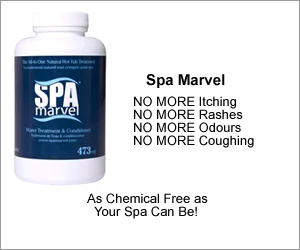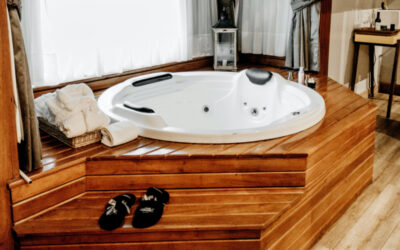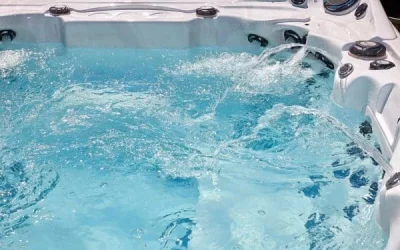How to Balance pH and Alkalinity in Your Hot Tub
Few things beat the relaxation of soaking in your hot tub after a long day. But while your spa can be a luxury, it’s also the perfect environment for bacteria growth. When spa water is not correctly maintained, microorganisms like bacteria and viruses can thrive, potentially creating unsafe water for bathers.
Maintaining proper pH and alkalinity levels is an important step in ensuring your hot tub water stays clean and safe. Below, we’ll review pH and alkalinity in detail and discuss maintaining balanced water levels.

The Relationship Between pH and Alkalinity Levels
Understanding the connection between pH and alkalinity contributes to finding the right balance.
The pH level of your water determines its acidity level on a scale of one (acidic) to 14 (basic), but it’s alkalinity that primarily influences water quality.
Alkalinity describes the water’s ability to balance acids and bases. The alkalinity level of your hot tub water dictates the buffer capacity, essentially determining how well your pH level resists change.
pH and alkalinity typically fluctuate together since they’re interconnected. When alkalinity levels are unstable, the buffer protecting your hot tub’s pH is inadequate.
Improper pH Levels in Hot Tubs
Ensuring accurate pH and alkalinity levels is essential for maintaining cleanliness and safety in your hot tub water. When pH levels are too high or too low, it can lead to various issues affecting water quality and bather comfort.
High pH in Hot Tubs and Spas
A pH level above 7.8 means that the water is too basic, which weakens chlorine’s ability to kill pathogens. Signs of high pH in spas or hot tubs include cloudy water, ineffective sanitizers, scale buildup on the spa walls, and algae growth.
Low pH in Hot Tubs and Spas
A low spa pH level (below 7.2) means the water is too acidic, which can impact both the equipment and bathers. Foamy water, equipment damage, and skin irritation can indicate low pH in a hot tub or spa.
When To Shock A Hot Tub
A spa should be shocked when combined chlorine levels are greater than 0.5 ppm, if there is an odour (including chlorine or bromine-type odours), or if the water isn’t sparkling.
Understanding Spa and Hot Tub Alkalinity
As a hot tub or spa owner, you should maintain alkalinity levels between 80-150 ppm. Alkalinity levels that exceed 150 ppm can make it challenging to stabilize pH levels.
When your hot tub water’s alkalinity is high, you may notice:
- Scale deposits on equipment
- Murky water, and
- Surfaces that feel rough to the touch.
Low alkalinity in your spa leads to a pH imbalance. Alkalinity levels below 80 ppm can alter your spa water’s ability to neutralize acids and bases.
If your hot tub or spa water’s alkalinity is too low, you may have difficulty maintaining pH levels and experience an increase in chemical demand. Water with a pH below 6.5 can be harmful to metal parts, especially if the alkalinity is also low, leading to corrosion.
Achieving Alkalinity and Hot Tub pH Balance
To balance your hot tub’s pH and alkalinity, you should complete the following five steps:
1. Test the Water: Utilize regular testing to track the pH and alkalinity levels in your hot tub or spa. Be sure to follow the directions so that you have an accurate reading and can make necessary adjustments.
2. Adjust Alkalinity: You usually want to address alkalinity before adjusting the pH levels. It would be wasteful to add additional chemicals when your spa water cannot maintain its pH level.
3. Adjust pH: After addressing the alkalinity, you can make the necessary adjustments to fix pH levels. The changes to alkalinity levels reinforce the buffer for your pH levels so the water can utilize the chemicals effectively.
4. Re-Test and Repeat: Once all adjustments are complete, re-test the water. If your alkalinity and pH levels are still abnormal, make further adjustments.
5. Monitor Levels: Regularly monitoring pH and alkalinity levels will help your spa remain in balance. This becomes particularly crucial following heavy use, rainfall, or additional water introduction.
Products to Use to Increase or Lower pH and Alkalinity
Using the correct products is key to enjoying clean, clear, and safe hot tub and spa water.
When balancing water, you must first look at the alkalinity. As an analogy, look at pH as a boat and alkalinity as the anchor. If the anchor (alkalinity) is not set, the boat (pH) drifts everywhere.
You’ll want to purchase an alkalinity increaser from a professional spa retailer to increase the alkalinity in a hot tub. Alkalinity increasers are designed to raise alkalinity and contain sodium bicarbonate.
While an alkalinity increaser does have an effect on pH, a separate product should be used to raise pH. This product is known as a pH increaser and contains sodium carbonate.
To lower pH and reduce alkalinity in hot tubs, use a product to lower pH (often called a pH reducer or pH minus). These products include chemicals like sodium bisulphate to increase acid levels in the water.
Once the alkalinity is in an acceptable range, check the pH. If it’s too low, use a pH increaser from a professional spa retailer that’s designed to raise pH and contains sodium carbonate.
In summary, you’ll want to use an alkalinity increaser to raise alkalinity, a pH reducer to lower both alkalinity and pH, and a pH increaser to raise pH.
Consider also using a treatment product to maintain pH and alkalinity levels for better overall water quality.
How to Balance Hot Tub Water in Specific Situations
Managing high and low pH levels alongside alkalinity in hot tubs and spas can be challenging. Here’s what to do in various scenarios to achieve optimal water balance and enjoyment.
High pH, Low Alkalinity in Hot Tubs
When the pH levels in your hot tub rise above 7.8, the water becomes excessively basic, causing ineffective sanitizer performance. When the alkalinity level in a hot tub is low, the water loses its ability to self-regulate pH levels.
To address high pH and low alkalinity, deactivate the spa jets and introduce a spa alkalinity increaser. Allow the product to absorb for 15 minutes before reactivating the jets.
After two hours, re-check the water’s alkalinity and add more hot tub alkalinity increaser if necessary.
Once the alkalinity stabilizes, wait 24 hours before reassessing the pH. If the pH remains elevated, use a pH reducer.
Low pH, High Alkalinity in Hot Tubs
In instances where your hot tub’s pH drops below 7.2, the water turns excessively acidic.
Deactivate the jets and lower the alkalinity using a pH reducer. Circulate the product using the jets and re-test the water after two hours – all while allowing the alkalinity to act as a buffer. Address the pH if necessary.
High pH and Alkalinity in Hot Tubs
Due to the closely linked relationship between pH and alkalinity, they commonly experience simultaneous fluctuations. Changes in one often lead to corresponding changes in the other – for example, high alkalinity in hot tubs can cause high pH levels.
Elevated pH and alkalinity levels create cloudy or murky water conditions and risk of bacteria formation. Calcium – naturally occurring in the water – will precipitate out of the solution and adhere to the spa walls, making them feel like 80 grit sandpaper.
To lower alkalinity in hot tubs, use a pH reducer. One tablespoon will lower alkalinity by about 10 ppm in 250 gallons of water. Aim for optimal alkalinity levels of 120 ppm to help ensure a stable environment.
After 24 hours, reevaluate the pH, which may naturally readjust without additional interventions. If the pH needs to be adjusted, use a pH increaser or reducer as required.
Low pH and Alkalinity in Hot Tubs
Signs like foamy water suggest an acidic environment with low pH and alkalinity levels. In such cases, the alkalinity’s insufficient buffer capacity fails to maintain pH stability, leading to an acidic imbalance.
To correct low pH and alkalinity in spas, use an alkalinity increaser while the jets are active. One tablespoon of alkalinity increaser will raise alkalinity levels by about 10 ppm in 250 gallons of water.
Prioritizing alkalinity first helps facilitate acid neutralization, elevating pH levels to a balanced state. If the pH isn’t in range after raising alkalinity to acceptable levels, use a product designed to raise or lower pH as required.
The Bottom Line: pH and Alkalinity Solutions
Maintaining the balance of pH and alkalinity levels in your hot tub or spa is essential for ensuring clean, safe, and enjoyable water. Regularly testing the water and using appropriate products can keep your hot tub or spa in optimal condition.
Remember, pH and alkalinity work hand in hand to create a stable environment for your water. Maintaining the delicate balance prevents issues such as corrosion, scale buildup, and bacterial growth. By following the steps outlined in this guide, you can stay proactive and maintain water quality.
Spa Marvel can assist if you want to spend even less time maintaining your hot tub or spa. Learn more about our products and discover how we can help keep your water balanced.









